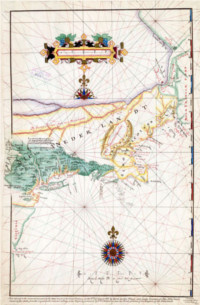New York Colony was originally New Netherland, Holland’s attempt to stake a claim in the new world.
The European nations were in a race to gain dominance of the new continent and to win naval dominance. With the British colonizing Virginia, Spain exploring the Caribbean and parts of South America, and France claiming Canada, the Dutch staked their claim in the Hudson River Valley.
In 1609, two years after the English settlers had established Jamestown colony, The Dutch East India Company hired Henry Hudson to find northeast passage across the continent to the Pacific Ocean and reach India from the east. He sailed up a river, landing in present day Albany where it became too shallow. He claimed this valley, and the river was named “Hudson River” after him.

Map of New Netherland 1614, by Adriaen Block, the first time it had been called that | Public domain Courtesy of Wikimedia Commons
The Dutch East India Company funded more trips there, primarily as business ventures to trade with the Iroquois Indians who populated that area, mostly for furs. In 1626, the Dutch made their legendary purchase of Manhattan Island for 60 guilders ($28) from the Indians, who didn’t understand the concept of buying and selling land.
While slow to settle at first, the “New Netherland” grew to be a large trade hub. During the 1650’s, it hit a period of rapid economic growth, especially when the Company wrote the Charter of Freedoms and Exemptions.
The charter gave parcels of land (excluding Manhattan) to people who could bring 50 people over the age of 15 to settle there. The owner/lord, or patroon (not a misspelling), would be chief magistrate and governor of his land, have credit with the company, and be involved in the trading company with only a 5 percent export fee. They would also be free of taxation for 10 years, though they would not be allowed to move during this time. They could tax their own citizens, choose a pastor, and build their own small villages. New Netherland became one of the largest ports in North America, settled with Dutch, English, Native Americans, and Africans who had been imported as slaves.
It grew to be such a large port with such a diverse population and busy trade, ports, and small towns, that it became the first colony on the continent that embraced cultural diversity, freedom of religion, and free trade.
The more the New Netherland expanded, however, the more it began to cause trouble with the surrounding English settlers and the Native Americans, whose land was being trespassed. The residents of New Netherland requested protection from the Dutch East India Company, who refused, not seeing the necessity. British charters and privateers began fighting with the Company to see who would be the dominant European naval power.
Charles II of England granted his brother James, Duke of York a large parcel of American territory that included New Netherland, New Amsterdam, and the surrounding area. James immediately sent four English frigates into New Amsterdam in 1664 and demanded New Netherland’s surrender. They had no choice but to comply.
James changed the name to New York and the land changed over to British ownership, though Dutch influences and architecture are still evident in that area today. The colors of the Dutch flag (blue, orange, and white) are found in the New York City flag, the New York Mets baseball club, New York Knicks basketball club, and New York Islanders hockey club, among others. The Dutch celebration of St. Nicholas (Saint Nicolaas) on December 6 is believed to have been the inspiration for “Santa Claus.”


